Are Trade Deficits Good or Bad for the US?

A trade deficit occurs when a country imports more than it exports — and that’s a good thing for a national economy. Or a terrible thing. Or it might not matter one way or the other. Trade deficits are so complex that economists can’t even agree on if they’re helpful or harmful. But if deficits are as terrible as some would have you believe, America is in deep trouble. The richest country in the world has run a trade deficit every single year since 1976.
Small Biz Spotlight: Don’t Miss Out on Nominating Your Favorite Small Business To Be Featured on GOBankingRates — Ends May 31
It’s a Simple Concept
In basic terms, a country runs a deficit — also called a negative balance of trade — when the value of the goods and services it buys from other countries is greater than the value of the goods and services that it sells overseas. In the United States, the Bureau of Economic Analysis (BEA) is the agency in charge of recording and defining America’s trade deficit.
The BEA defines imports as goods that are produced in foreign countries and that pass through U.S. customs for sale in America.
Exports are goods that are produced in the United States and that pass through customs going the other way for sale in foreign countries.
An imbalance with more than one country is called a multilateral trade deficit, as opposed to a bilateral trade deficit, which exists between only two countries. America’s biggest bilateral trade deficit by far is with China — $310.8 billion in 2020 alone.
Subtract exports from imports in a given time period and you’ve got the trade deficit. The U.S. imported about $2.81 trillion worth of goods and services in 2020 but exported only about $2.13 trillion for a trade deficit of $678.7 billion.
Simple math, right? The BEA’s economists wish it were that easy.
More Economy Explained: All About the Federal Budget and Its Role in Your Life
But It Gets Complicated Quickly
An imbalance between stuff coming in and stuff going out is a simplification that’s easy to understand, but trade deficits also occur when:
A country borrows from other countries to pay for imports.
The dollar strengthens and imports become cheaper.
A country ships raw materials overseas to manufacture products in another country. In that case, the raw materials count as exports, but if the manufactured products those raw materials become re-enter the country, they count as imports and are subtracted from the GDP.
An American pays for services overseas — like hotel stays, restaurant meals and even traveling itself — all of which the BEA counts as imports. These same rules apply to services that are harder to quantify, like business advertising, licensing and royalties.
But it gets even trickier than that. America’s trade balance is just one part of a larger diagnosis of the country’s give-and-take relationship with the international community. Called the “balance of payments,” this measure of the U.S. economy’s transactions with the rest of the world includes the trade balance as well as things like the buying and selling of foreign assets.
Discover: What Is the Consumer Confidence Index and How Does It Affect Me?
The Great Deficit/Debt Debate
The Council on Foreign Relations points out that some economists consider trade deficits to be the same as debts because they represent a negative economic imbalance — America spends more on things it buys overseas than it earns from things it sells overseas. Others, like those at the Cato Institute, argue just as convincingly that trade deficits are not the same as debts to be repaid by future generations. It’s different than debt, they argue, because deficits don’t always have to be repaid, they often involve unfavorable terms for the lender when they do and they give something tangible to future generations to exchange if they ever do find themselves on the hook.
It’s worth noting that trade deficits are among the rare issues that often unite the political and philosophical right and left. Both Bernie Sanders and Donald Trump, for example, despise trade deficits, albeit for different reasons.
Learn: National Debt and Deficit — What Is It and How Does It Affect Me?
Trade Deficits Aren’t Always Bad
There is a lot of stigma around trade deficits, and it’s easy to view counties that run deficits as “losing” to trade partners that run surpluses, but that’s a convenient simplification of a very complex dynamic. Deficits can improve a country’s standard of living, for example, by exposing its population to new products from different markets that are produced at competitive prices. Those low prices keep inflation in check, and anyway, there’s no direct correlation between a trade surplus and a strong economy.
But They Sure Can Be
Those previously mentioned gains are often fleeting. The longer a country runs a deficit, the more likely it is that businesses in industries dominated by imports will ship jobs overseas.
Find Out: What Is Inflation and What Does It Mean When It Goes Up or Down?
In times of currency devaluation, imports can become more expensive and when a country is too dependent on imports, its economy can be especially vulnerable to economic downturns. In the end, the widgets you like to buy from China might be cheaper when America runs a deficit, but if you work in a factory that makes those same widgets, you might want to consider a side hustle.
This article is part of GOBankingRates’ ‘Economy Explained’ series to help readers navigate the complexities of our financial system.
More From GOBankingRates
Money’s Most Influential: Where Do Americans Get Their Financial Advice?
‘Rich Dad Poor Dad’ Author Robert Kiyosaki: You Should Never Say ‘I Can’t Afford That’
Here’s How Much You Should Have in Your 401(k) Account, Based on Your Age
Last updated: May 4, 2021
This article originally appeared on GOBankingRates.com: Are Trade Deficits Good or Bad for the US?
